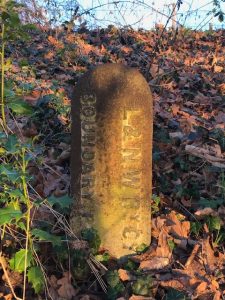FoGS volunteers meet on the second Sunday of each month, so the next working party will be on 12th February. There’s a car park at the station, but you could choose greener transport by walking or cycling (there’s a new rack for your bike!). You may have noticed a smart new noticeboard at the entrance to platform one. It’s there to help us to publicise FoGS and Goostrey Art Studio more effectively. For more information, have a look at our website or contact our chair Dave Roberts on 07494 976779.
As well as improving the environment around Goostrey Station, members of FoGS are interested in the history of our local railway. A few years ago they restored an oil lamp that used to illuminate the platform and they retrieved the keystone of the former road bridge; now both are mounted on the wall at the end of platform one. Recently they located a boundary post – a marker which showed the limit of railway land – in the old sidings. Often these posts were used where it was difficult to install a fence or hedge, where there was a risk of encroachment by other landowners, or where there had been a dispute over land ownership. So we expect to find more at Goostrey. A boundary post has a very long base that was buried deep in the ground to discourage landowners from digging it up and moving it! The inscription explains its function and reads “L & N W Ry Co Boundary Post”. It was probably made in the foundry at the London & North Western Railway’s Crewe works.
The LNWR was formed in 1846 by the amalgamation of three major railway companies – the Grand Junction Railway, the London and Birmingham Railway and the Manchester and Birmingham Railway (which in practice only ran from Manchester to Crewe). The network linked London to Birmingham, Cheshire, Liverpool, Manchester, Wales and Ireland. The company built rolling stock and locomotives at three major centres: Crewe, Earlestown and Wolverton. The locomotives were painted ‘blackberry black’ and their coaches ‘purple lake’, which gave them a distinctive appearance amongst the green, chocolate and cream of the Great Western Railway and the red of the Midland Railway. In 1923, the LNWR was absorbed into the London, Midland & Scottish Railway. It joined with the Midland, Lancashire & Yorkshire, Caledonian, Glasgow South Western, Highland, North Stafford, Furness and a few smaller railways.
If you have photos or stories about the history of Goostrey railway station that you could share with FoGS, please get in touch with Chris Burgess on 07976 894737.




